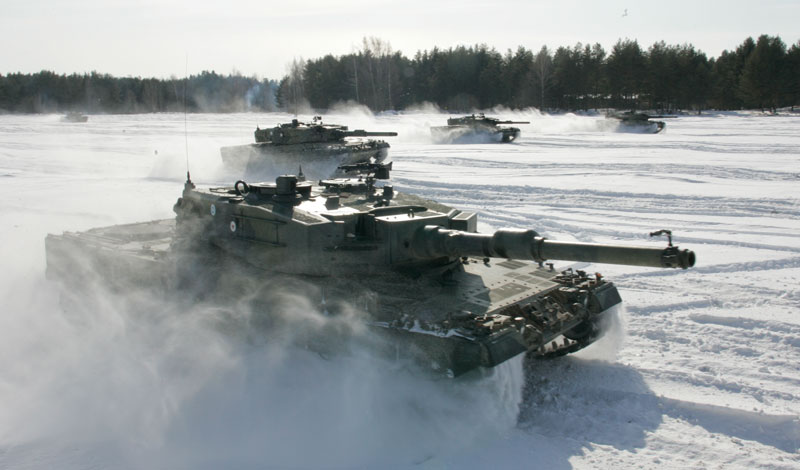Russian Aggression Prompts Finnish-Swedish Military Pact
By Kasper Viita

Finland armored brigade with their newly acquired Leopard 2 MBTs tanks positioned near border with Russia
The countries yesterday agreed to conduct a study by October to find ways to ensure that money spent on arms will stretch a longer way. Cooperation will begin next year with a focus on 2016 and beyond, according to Finnish Defense Minister Carl Haglund and his Swedish counterpart Karin Enstroem.
Finland and Sweden aren’t members of the NATO (North Atlantic Treaty Alliance), though they joined the European Union in 1995. Finland shares a 1,340-kilometer (830-mile) border with Russia - - more than the other 27 EU members combined -- and fought two wars against the Soviet Union during World War II. Popular opposition has stopped the two countries from joining NATO.
“We have a neighbor who has demonstrated a couple of times in the past six years that military power and the threat of using it are simply instruments in the political toolbox,” Charly Salonius-Pasternak, security policy researcher at the Finnish Institute of International Affairs, said by phone yesterday. “For a small nation, this is a terrifying idea.”
Strategic Blow
Popular opposition to joining NATO has centered on the belief that Russia is becoming slowly more democratic and that economic ties will keep conflicts from escalating, Salonius-Pasternak said. That argument has now “received a strategic blow.”
According to NATO, Russia has amassed about 40,000 troops along the Ukrainian border since annexing Crimea in March, prompting the worst standoff with the U.S. and the EU since the Cold War.
Finland sells about 10 percent of all exported goods in Russia, its biggest trade partner. More than 80 percent of Finland’s imports from its eastern neighbor are energy products, including 100 percent of natural gas used in Finland, according to data by the customs office.
The defense cooperation announced yesterday is limited to peacetime, according to the ministers. Still, it also implies improving potential war-time capabilities, Salonius-Pasternak said. “No reasonable politician can any longer say that the situation is as before and that Russia’s increasing military might poses no problems,” he said.
Complementary Strengths
The armed forces of the two Nordic nations are in some ways complementary to each other. Sweden said last month it plans to fit its fighter jet fleet with long-range cruise missiles while Finland in March canceled the planned MGM-140 ATACMS long-range missile system purchase. Finland’s navy doesn’t have submarines where Sweden has a fleet of five. Finland holds stronger infantry reserves thanks to its compulsory military service, abolished in Sweden in 2010.

Sweden plans to spend 5.5 billion kronor ($850 million) more on defenses each year by 2023, including purchases of more fighter jets and submarines. Finland must also find a way to replace its fleet of jets that’s reaching the end of its lifespan in about 10 to 15 years. Finland may increase spending on its military due to the crisis in Ukraine, Haglund said.
Natural Focus
“The web of treaties and agreements we’ve focused on building has in a way been torn apart, we have to react on that,” Sweden’s Enstroem said. “It’s natural that more focus has been directed to defense” in the Nordic region.
Sweden may triple its defense budget
The pact with Sweden doesn’t conflict with possible membership discussions with NATO, Haglund said. While neither country has applied for membership in the alliance, they are paying close attention to each other’s stances toward the bloc.
Justifications for the pact and for NATO entry are very similar, Salonius-Pasternak said. Sharing equipment costs and improving air- and naval-defense capabilities are the main attractions to working together, he said.
“The same logic applies in both instances, the difference is collaborating with one country or almost thirty countries,” he said. “As long as Finland has defense forces with similar tasks as now, we need a certain number of fighter jets and their armament.”

Swedish fighter-jets Saab JAS 39 Grippen
The cost to replace the 62 F-18 Hornet jets acquired in the early 1990s is estimated to be at least 5 billion euros ($7 billion), Haglund has said. It compares with 6.8 billion euros of austerity measures introduced by the government since 2011.
Not Enough
Sweden’s armed forces don’t have enough staff or equipment to defend the country, according to an April report by the National Audit Office. Supreme Commander Sverker Goeranson in 2012 said that the military can only defend a limited area for about a week without outside help. Sweden has cut the budget of its once-formidable armed forces after the end of the Cold War, opting to focus on international missions in countries including Afghanistan, Sudan and Kosovo.
Similar concerns were voiced by Finnish officers in a survey conducted by the Finnish Officers’ Union in January. Military spending is “inadequate” for maintaining independent, credible defenses, according to 77 percent of officers who responded to the survey. The survey also showed the majority of Finnish officers support joining NATO. The government should pay more heed to their views, Salonius-Pasternak said.
“It’s pointless that the field experts aren’t being heard in an issue because it’s considered too political,” he said. “That’s like excluding the nuclear safety authority from a discussion on building a new nuclear reactor.”

No comments:
Post a Comment